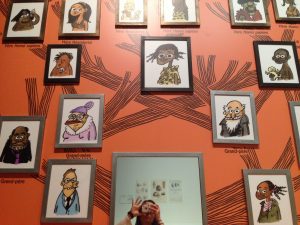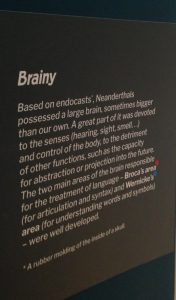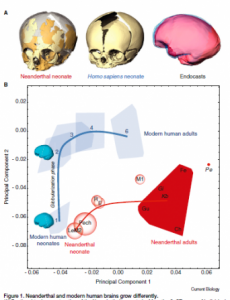
This Wednesday, after classes, we went to the Musée de l’Homme: the museum of man… This anthropology museum tells the story of the evolution of man and also focuses on the customs and material culture of different cultures. But we were in for a special treat, since the museum was hosting a Neanderthal exhibit. As Neuroscience students, that is most interesting to us, since it allows for a peak into the evolution of the human brain and culture and some speculation into the possible interactions modern humans and Neanderthals might have had. After all, we now have evidence of mating between the two species (Weaver & Roseman, 2005).

So, if we can mate, can we really say that Homo neanderthalensis and Homo sapiens are different species at all? That is one of the big debates of paleoanthropology that is still going on. Just a few months ago a paper got published that showed that Neanderthal cave art dates back before modern humans even made it to Europe, so unlike what was previously thought, Neanderthals did not learn art from modern humans, they already knew it (Hoffmann et al., 2018).

We have a dilemma happening here: If Neanderthals basically look like shorter, more muscular versions of modern humans, and they also could mate with modern humans, and they had their own culture (something that anthropologists have believed to be uniquely H. sapiens, and were proud of it), than are we different species in the first place?

The museum also asked that same question a couple of times, and one of the educational games I played there offers a survey at the end, it asks the age-old question plaguing anthropology to the visitors of the museum: Do you think humans and Neanderthals are actually the same species? And maybe surprisingly the answer was about 60% of the time “yes”. Take that the cave men of Hollywood!
This all of course depends on how we choose to define “human” in the first place. Our research for the brief debate we had on the subject in my Antro 307W: Human Evolution class, had led us to learn that the growth patterns of modern humans and Neanderthals are different, they grow up faster and have a shorter childhood. The unusually long childhood of modern humans is thought to be due to our large encephalization (brain to body ratio) but the Neanderthal and modern human brain sizes are comparable (and according to the Musée de l’Homme exhibition Neanderthal brains are even a bit larger). To explain the disparity, the experts have turned to the growth stages of the brain. The ancestral head shape of hominins (as observed from chimps) are elongated, but during the first 2 years of life, the modern human babies develop a more globular head shape, a phase thought to be associated with different cognitive characteristics of “being human” and one that Neanderthals don’t go through (Gunz, Neubauer, Maureille & Hublin, 2010).

So it is up to you to decide if you saw a Neanderthal on the street, if you would call them human or not.

Referances:
Gunz, P., Neubauer, S., Maureille, B., & Hublin, J. (2010). Brain development after birth differs between Neanderthals and modern humans. Current Biology, 20(21), R921-R922. doi: 10.1016/j.cub.2010.10.018
Hoffmann, D., Standish, C., García-Diez, M., Pettitt, P., Milton, J., & Zilhão, J. et al. (2018). U-Th dating of carbonate crusts reveals Neandertal origin of Iberian cave art. Science, 359(6378), 912-915. doi: 10.1126/science.aap7778
Weaver, T., & Roseman, C. (2005). Ancient DNA, Late Neandertal Survival, and Modern‐Human–Neandertal Genetic Admixture. Current Anthropology, 46(4), 677-683. doi: 10.1086/432776
